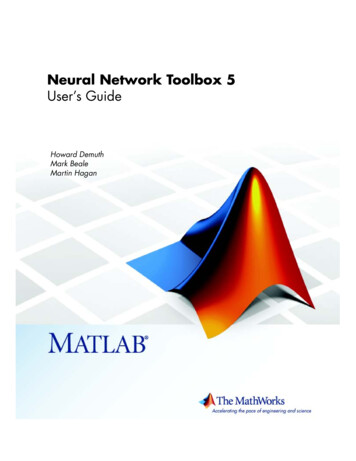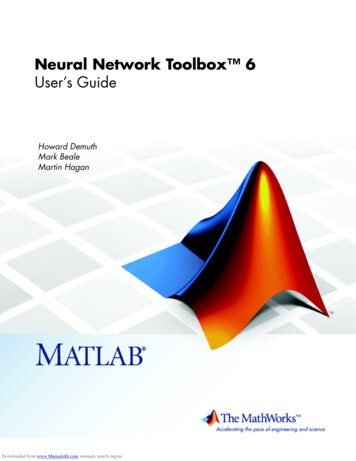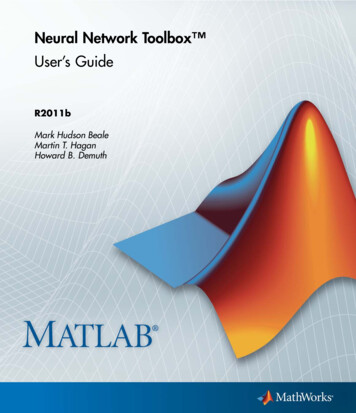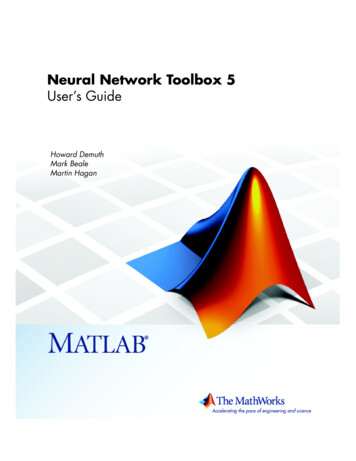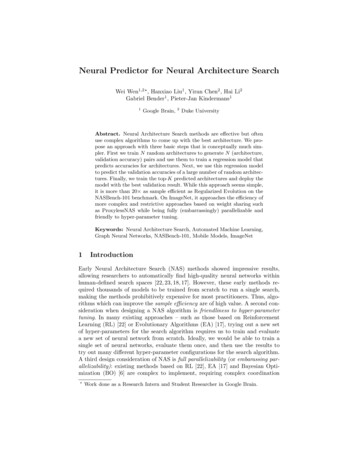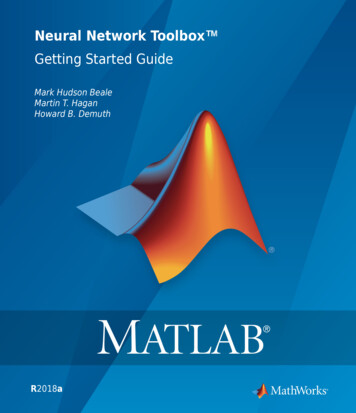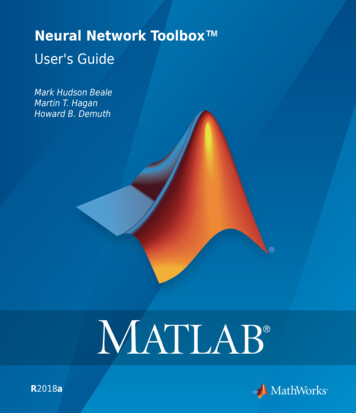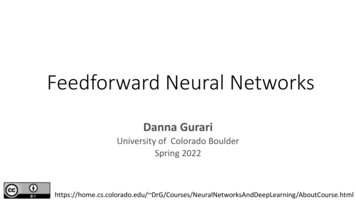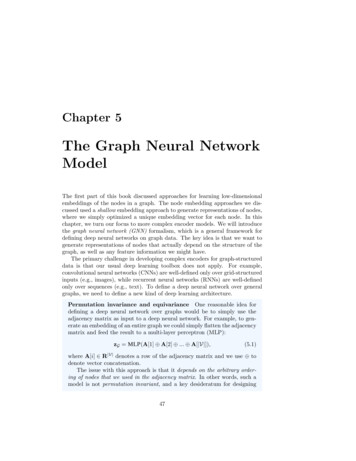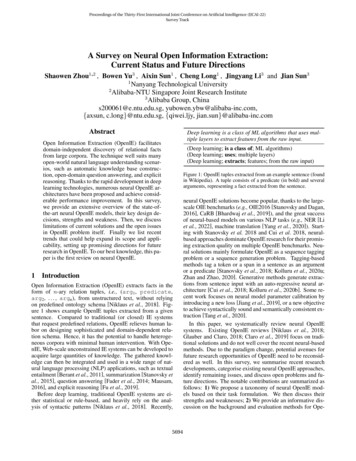
Transcription
Proceedings of the Thirty-First International Joint Conference on Artificial Intelligence (IJCAI-22)Survey TrackA Survey on Neural Open Information Extraction:Current Status and Future DirectionsShaowen Zhou1,2 , Bowen Yu3 , Aixin Sun1 , Cheng Long1 , Jingyang Li3 and Jian Sun31Nanyang Technological University2Alibaba-NTU Singapore Joint Research Institute3Alibaba Group, Chinas200061@e.ntu.edu.sg, yubowen.ybw@alibaba-inc.com,{axsun, c.long}@ntu.edu.sg, {qiwei.ljy, jian.sun}@alibaba-inc.comAbstractDeep learning is a class of ML algorithms that uses multiple layers to extract features from the raw input.Open Information Extraction (OpenIE) facilitatesdomain-independent discovery of relational factsfrom large corpora. The technique well suits manyopen-world natural language understanding scenarios, such as automatic knowledge base construction, open-domain question answering, and explicitreasoning. Thanks to the rapid development in deeplearning technologies, numerous neural OpenIE architectures have been proposed and achieve considerable performance improvement. In this survey,we provide an extensive overview of the state-ofthe-art neural OpenIE models, their key design decisions, strengths and weakness. Then, we discusslimitations of current solutions and the open issuesin OpenIE problem itself. Finally we list recenttrends that could help expand its scope and applicability, setting up promising directions for futureresearch in OpenIE. To our best knowledge, this paper is the first review on neural OpenIE.1(Deep learning; is a class of; ML algorithms)(Deep learning; uses; multiple layers)(Deep learning; extracts; features; from the raw input)Figure 1: OpenIE tuples extracted from an example sentence (foundin Wikipedia). A tuple consists of a predicate (in bold) and severalarguments, representing a fact extracted from the sentence.IntroductionOpen Information Extraction (OpenIE) extracts facts in theform of n-ary relation tuples, i.e., (arg1 , predicate,arg2 , . . . , argn ), from unstructured text, without relyingon predefined ontology schema [Niklaus et al., 2018]. Figure 1 shows example OpenIE tuples extracted from a givensentence. Compared to traditional (or closed) IE systemsthat request predefined relations, OpenIE relieves human labor on designing sophisticated and domain-dependent relation schema. Hence, it has the potential to handle heterogeneous corpora with minimal human intervention. With OpenIE, Web-scale unconstrained IE systems can be developed toacquire large quantities of knowledge. The gathered knowledge can then be integrated and used in a wide range of natural language processing (NLP) applications, such as textualentailment [Berant et al., 2011], summarization [Stanovsky etal., 2015], question answering [Fader et al., 2014; Mausam,2016], and explicit reasoning [Fu et al., 2019].Before deep learning, traditional OpenIE systems are either statistical or rule-based, and heavily rely on the analysis of syntactic patterns [Niklaus et al., 2018]. Recently,5694neural OpenIE solutions become popular, thanks to the largescale OIE benchmarks (e.g., OIE2016 [Stanovsky and Dagan,2016], CaRB [Bhardwaj et al., 2019]), and the great successof neural-based models on various NLP tasks (e.g., NER [Liet al., 2022], machine translation [Yang et al., 2020]). Starting with Stanovsky et al. 2018 and Cui et al. 2018, neuralbased approaches dominate OpenIE research for their promising extraction quality on multiple OpenIE benchmarks. Neural solutions mainly formulate OpenIE as a sequence taggingproblem or a sequence generation problem. Tagging-basedmethods tag a token or a span in a sentence as an argumentor a predicate [Stanovsky et al., 2018; Kolluru et al., 2020a;Zhan and Zhao, 2020]. Generative methods generate extractions from sentence input with an auto-regressive neural architecture [Cui et al., 2018; Kolluru et al., 2020b]. Some recent work focuses on neural model parameter calibration byintroducing a new loss [Jiang et al., 2019], or a new objectiveto achieve syntactically sound and semantically consistent extraction [Tang et al., 2020].In this paper, we systematically review neural OpenIEsystems. Existing OpenIE reviews [Niklaus et al., 2018;Glauber and Claro, 2018; Claro et al., 2019] focus on traditional solutions and do not well cover the recent neural-basedmethods. Due to the paradigm change, potential avenues forfuture research opportunities of OpenIE need to be reconsidered as well. In this survey, we summarise recent researchdevelopments, categorise existing neural OpenIE approaches,identify remaining issues, and discuss open problems and future directions. The notable contributions are summarized asfollows: 1) We propose a taxonomy of neural OpenIE models based on their task formulation. We then discuss theirstrengths and weaknesses; 2) We provide an informative discussion on the background and evaluation methods for Ope-
Proceedings of the Thirty-First International Joint Conference on Artificial Intelligence (IJCAI-22)Survey TrackTagging based ModelNilSubj-B Subj-I Pred-BSubjGenerative ModelNilNilNilTag DecoderTag Decoderh1h2(h1;h1) (h1;h2) (h1;h3)Span RepresentationPair RepresentationEncoderx1x2h2h3h1.xnx1x2.(b) Span-basedh2 s subj s1 s2 /subj . /s xnx1x2Tuple GeneratorTuple GeneratorEncoderEncoderh3EncoderEncoder(a) Token-based s subj s1 s2 /subj . /s Tag Decoders(h1;h1) (h1;h2) (h1;h3)h1h3B2E Nil Node tagsNil B-S2P Edge tags.xn(c) Graph-basedx1x2.xn(d) Extraction generatingx1Discriminator(subj; pred; obj)x2.xn(e) Adversarial examples generatingFigure 2: A taxonomy of neural OpenIE model architecturesnIE. We also offer a detailed comparison of current SOTAmethods; 3) We discuss three challenges that restrict the development of OpenIE: evaluation, annotation, and application. Based on them, we highlight future directions: moreopen, more focused and more unified.2Neural OpenIE SolutionsFormally, given a sentence as a sequence of tokens/wordsS ⟨w1 , w2 , . . . , wn ⟩, OpenIE outputs a list of tuples T T1 , T2 , . . . , Tp with the i-th tuple Ti ⟨ai1 , pi , ai2 , ., aiq ⟩representing a fact in the source sequence. Here, pi denotesthe predicate in Ti , and aij is pi ’s j-th argument. The first argument in a tuple is considered as the subject. The maximumnumber of arguments m per tuple is pre-defined: m 2 forbinary and m 3 for n-ary relation extraction.Based on task formulation, we categorize neural OpenIEmodels into tagging-based models and generative models, seeFigure 2. Next, we review architectures in the two categories,and brief solutions that focus on parameter calibration.2.1Tagging-based ModelsTagging-based models formulate OpenIE as a sequence tagging task. Given a set of tags each of which indicates a role(e.g., argument, predicate) of a token or a span of tokens, themodel learns the probability distribution of the tag of eachtoken or span conditioned on sentence. Then, the OpenIEsystem outputs tuples based on the predicted tags.Tagging-based OpenIE models share a similar architectureto other neural models for sequence tagging tasks in NLP(e.g., NER [Li et al., 2022]). A model usually contains threemodules: an embedding layer to produce distributed representation of tokens, an encoder to generate context-aware token representations, and a tag decoder to predict the tag basedon token representation and tagging scheme. The embedding layer often concatenates word embeddings with syntactic feature embeddings to better capture syntactic informationin sentence. Recently, pre-trained language models (PLMs)have showed superior performance across various NLP tasks[Devlin et al., 2019]. Because PLMs produce context-awaretoken representations, they can be used either to produce token embedding or as encoders.Based on tagging schemes, we categorize the models intotoken-based, span-based, and graph-based models.5695Token-based ModelsToken-based models predict whether a token is (or a part of)an argument or a predicate. A common tagging scheme isBIO for Beginning, Inside, and Out of a role i.e., argumentand predicate. Figure 2(a) gives an example of a two-tokensubject and one-token predicate. A token is tagged with ‘O’if it is not part of an argument or predicate.RnnOIE [Stanovsky et al., 2018] considers part-of-speech(POS) feature, and uses Bi-directional LSTM (BiLSTM) [Srivastava et al., 2015] to capture sentence context. It appliesfully connected network with softmax layer on the output ofthe encoder, to produce probability distributions over all tagsfor each token. SenseOIE [Roy et al., 2019] follows RnnOIE’s model structure and introduces one-hop neighboursof a token in dependency tree as syntactic features. Insteadof predicting all tags in a single task, Multi2 OIE [Ro et al.,2020] designs two sub-tasks. One predicts predicate and theother predicts the arguments that are associated to the predicted predicate. Representation of predicate tokens are usedas a feature to predict arguments. The model is also the firstusing PLM as sentence context encoder. OpenIE6 [Kolluru etal., 2020a] implements an iterative grid labeling (IGL) system that organizes tag sequences in a 2D grid. Each sequencecorresponds to an extraction. It uses a PLM to obtain contextualized token embedding, then feeds them to a transformerbased network [Vaswani et al., 2017]. The latter decodes multiple sequences of tags iteratively based on sentence input andembedding of the labels obtained in the previous step.Token-based model is straightforward. However, arguments and predicates are often token spans. Models whichpredict tags for individual tokens may not well capture thehigher-level relationship among arguments and predicates.Span-based ModelsSpan-based models directly predict whether a token span is anargument or a predicate. Figure 2(b) gives an example span(h1 ; h2 ) which is identified as a subject from input. Typically,all possible token spans are enumerated from input sentence.Each token span is then assigned a tag indicating its role ofpredicate, an argument, or otherwise not to be extracted. Enumerated token spans may overlap with others. In general, atoken span representing an argument should not overlap withthe one representing a predicate. This case can be handledduring inference using hand-crafted constraints. For model
Proceedings of the Thirty-First International Joint Conference on Artificial Intelligence (IJCAI-22)Survey Trackdesign, SpanOIE [Zhan and Zhao, 2020] considers POS anddependency relation between a token and its syntactic parentas syntactic features, and uses BiLSTM to produce contextualized token representation. Representation of a span is derived from the representation of its first and last tokens. Tagdecoder then decodes tag from span representation.Span-based methods consider a token span as the basic unitwhen deciding argument or predicate labels. This may helpthe model capture relationship among arguments and predicates. However, too many candidate spans that are neither argument nor predicate are generated, and it is time-consumingto enumerate all spans. Existing methods often set a maximum span length. Span-based methods also have difficultyin extracting tuple elements with discontinuous tokens, e.g.,“geography books” is an argument with discontinuous tokensin sentence “Alice likes geography and history books”.Graph-based ModelsGraph-based models build a graph on token spans to identifytriplets. MacroIE [Yu et al., 2021a] constructs a graph withnodes being token spans, and edges indicating the connectednodes belonging to the same fact. It extracts tuples by findingmaximal cliques in the graph. To construct nodes, it assigns abinary indicator (i.e., B2E tag shown in Figure 2(c)) to eachtoken span; if the indicator is true, then the token span is anode. To construct edges, it assigns tags to a boundary token pair. Each token in the pair is from one token span. Theassigned tag consists of two parts. The first part indicateswhether the two boundary tokens are both at the beginning orat the end of the two corresponding token spans. The secondpart indicates the role of the two token spans. For example,B-S2P tag shown in Figure 2(c) means that token x1 andx3 are at the start of a subject and a predicate spans respectively. The model learns node and edge representations usingthe same architecture. It uses a BERT-based encoder to learncontextualized token representation. The model then derivesspan’s representation from token representations, and predictslabels with a simple tag decoder.Graph-based methods model association between tuple elements, instead of directly predicting tuples. They can extractall tuples in a single run, and better handle overlapping anddiscontinuous arguments or predicates. However, the currentdesign assigns labels to all token pairs, leading to a large number of NULL labels. The imbalanced label distribution mayalso harm the model’s performance.2.2Generative ModelsGenerative models formulate OpenIE as a sequence generation problem that reads a sentence and outputs a sequenceof extractions. Figure 2(d) gives an example of the generated sequence. Formally, given a sequence of tokens Sand the expected extraction sequence Y ⟨y1 , y2 , . . . , ym ⟩,the model maximises the conditional probability P (Y S) Qmi 1 p(yi y1 , y2 , . . . , yi 1 ; S). There is also work whichgenerates adversarial tuples with the goal of making it difficult for a classifier to distinguish them from golden tuples.Generate Extractions. The generative model architecturetypically consists of: an encoder to give a distributed representation of the sentence context, and a decoder to gen-5696erate tuples sequentially, based on sentence context and thesequence generated so far. NOIE [Cui et al., 2018] uses a3-layer stacked LSTM as both encoder and decoder. To handle out of vocabulary (OOV) issues and retain informationin source sentence, it applies a simplified copy mechanism[Gu et al., 2016] to copy words from the source sentence tothe generated sequences. It also applies attention mechanism[Bahdanau et al., 2015] for the RNN-based decoder to refer to the whole input sequence, instead of relying solely onthe context representation produced by the encoder. Logician[Sun et al., 2018] uses bi-directional GRU [Cho et al., 2014]as both encoder and decoder. It reduces the vocabulary sizeto include only predefined keywords, so that more words willbe copied from the source sentence. It also implements thecoverage mechanism [Tu et al., 2016] and explores encodingdependency parse features in the alignment model. The purpose is to reduce redundant extractions and to improve prediction accuracy. IMoJIE [Kolluru et al., 2020b] uses BERTas encoder, and LSTM as decoder. Focusing on the redundantextraction issue in generative OpenIE models, it proposes aniterative tuple generation mechanism. This mechanism appends all tuples generated previously to the source sentenceas the input, to produce the next tuple. It allows the decoderaccessing all previous extractions directly, but seriously slowsdown the extraction speed.Generate Adversarial Examples. Adversarial-OIE [Hanand Wang, 2021] is based on Generative Adversarial Network(GAN) [Goodfellow et al., 2014]. The model aims to obtaina generator which can generate tuples so similar to the goldannotations that a discriminator cannot distinguish them. Thearchitecture consists of a transformer-based tuple generator,a Convolutional Neural Network (CNN) based discriminator,and policy gradient method REINFORCE [Williams, 1992]for optimizing the generator in an adversarial manner.2.3Model ComparisonCompared with generative models, most tagging-based models are non-autoregressive. This fundamental difference leadsto four typical model differences: 1) Extraction dependency. Auto-regressive models predict next tuples based onprevious predictions, leading to unnecessary sequential dependency among tuples. This dependency may cause errorpropagation among multiple steps. At the same time, suchdependency may also leverage correlation between facts, torealize reasoning for better extraction. 2) Extraction flexibility. Tagging-based models are not as flexible as generative models. They assign labels to tokens and extract tokenswithout modification; thus the extracted tuples may be incoherent. Consider an example sentence “Born in 1879, AlbertEinstein is one of the most influential scientist of the 20th century.” The predicate of an extraction may be “born in”, but amore coherent predicate is “was born in”. Though OpenIE6partially solves this problem by introducing supplementarywords such as “is”, “of” and “for”, the cases such as predicate needs adjustment according to syntactic rules remain unsolved. 3) Extraction faithfulness. On the other hand, theflexibility of generative models also brings in the risk of unfaithful extraction: meaningless facts that are not expressedin the original text may be generated. 4) Extraction speed:
Proceedings of the Thirty-First International Joint Conference on Artificial Intelligence (IJCAI-22)Survey TrackOpenIE SystemOIE16F1AUCRule-basedClausIE [Del Corro and Gemulla, 2013]OpenIE4 [Mausam, 2016]59603842-6269.4-4849.1-GenerativeNOIE [Cui et al., 2018]IMoJIE [Kolluru et al., 2020b]-Calibrating RnnOIE Model[Jiang et al., 2019][Tang et al., 2020]-Tagging-basedRnnOIE [Stanovsky et al., 2018]SenseOIE [Roy et al., 2019]SpanOIE [Zhan and Zhao, 2020]Multi2 OIE [Ro et al., 2020]OpenIE6 [Kolluru et al., 2020a]MacroIE [Yu et al., 2.251.153.332.833.3-31.532.212.515.9------Table 1: The performance of neural OpenIE systems on two popular benchmarks OIE2016 and CaRB, each with multiple partial matchingstrategies. The best results under each evaluation setting (based on the available scores) are in boldface, and the second best are underlined.The results missing in the literature are marked as “-”. Since Logician is only evaluated on a Chinese benchmark, and Adversarial-OIE onlygives precision-recall curve without AUC score on OIE2016, these two systems are not listed here. For comprehensiveness, we also includescores of two popular rule-based systems i.e., ClausIE and OpenIE4.Autoregressive models output results step by step. Being nonautoregressive, tagging-based methods can output results simultaneously by taking advantage of GPU parallelism. Forexample, the inference speed of the SOTA tagging modelMacroIE [Yu et al., 2021a] is about 35 times faster than generative model model IMoJIE [Kolluru et al., 2020b].2.4Calibrating Neural OpenIE ModelsSome work focuses on calibrating parameters of existing neural models to improve extraction quality. [Jiang et al., 2019]adds a new optimization goal to a tagging based model. Thebasic idea is to normalize confidence scores of the extractions, so that they are comparable across sentences. The optimization goal minimizes the binary classification loss whichdistinguishes correct extractions from wrong ones across different sentences. In addition, the authors also propose an iterative learning mechanism which incrementally includes extractions that participate in the computation of binary classification loss. This mechanism calibrates model parameters,and improves training examples for binary classification atthe same time, leading to improved performance. [Tang etal., 2020] proposes a syntactic and semantic-driven reinforcement learning method to enhance supervised OpenIE models(e.g., RnnOIE). It also improves the confidence score by incorporating an extra semantic consistency score.3Performance EvaluationIn OpenIE, the input sentence is not restricted to any domain,and the extraction process does not rely on any predefinedontology schema. Hence, it becomes a challenge to derive aunified standard to judge the quality of extractions.Since neural-based solutions are evaluated on benchmarkdatasets [Stanovsky and Dagan, 2016; Bhardwaj et al., 2019],5697we first introduce their annotation standards. Common annotation standards include completeness, correctness, and minimality. Completeness requires an OpenIE system to extractall information in a sentence. Correctness requires the extracted tuples to be implied from the sentence, and to havemeaningful interpretation. Minimality requires the elementsof a tuple to be indivisible units. Consider an example sentence “Jeff Bezos founded Amazon and Blue Origin”. “Amazon and Blue Origin” should be two arguments “Amazon”and “Blue Origin”, i.e., two extractions are formed.3.1Evaluation SettingOpenIE systems are typically evaluated by comparing the extractions with the gold set. Commonly used measures are F1and PR-AUC scores. Table 1 lists the results collected fromliterature on two English benchmarks: OIE2016 [Stanovskyand Dagan, 2016] and CaRB [Bhardwaj et al., 2019].OIE2016 is the first large-scale OpenIE benchmark. It iscreated by automatic conversion from QA-SRL [He et al.,2015], a semantic role labeling dataset. The sentences arefrom news (e.g., WSJ) and encyclopedia (e.g., WIKI) domains. Since there are no restrictions on the elements of OpenIE extractions, partial-matching criteria instead of exactmatching is typically used. Hence, the evaluation script cantolerate the extractions that are slightly different from the goldannotation. OIE2016 proposes to follow the matching criteria introduced in [He et al., 2015], and considers two tuples amatch if both share the same grammatical head of all of theelements. However, [Jiang et al., 2019] noted that the evaluation metric implemented in the public code of OIE2016 usesa more lenient lexical overlap instead. [Jiang et al., 2019] and[Tang et al., 2020] follow syntactic-head matching metric andreport much lower scores than those in the OIE2016 originalpaper. In Table 1, columns “OIE16” and “OIE16(S)” list the
Proceedings of the Thirty-First International Joint Conference on Artificial Intelligence (IJCAI-22)Survey Trackresults of using OIE2016 data evaluated by lexical-match andsyntactic-head matching criteria respectively.CaRB [Bhardwaj et al., 2019] is developed by reannotating the dev and test splits of OIE2016 via crowdsourcing. Besides improving annotation quality, CaRB alsoprovides a new matching scorer. CaRB scorer uses tokenlevel match and it matches relation with relation, argumentswith arguments. The authors also design an extractiongold pair match table which records the similarity scores ofextraction-gold pairs for a sentence. During precision computation, each extraction is matched exclusively to one goldtuple. The extraction having the highest matching score witha gold tuple form the first exclusive match. Then the matchedgold tuple is removed from the subsequent matching. Thenext extraction having the highest matching score with oneof the remaining gold tuples forms the next exclusive match.The same matching process applies to all of the remainingextractions. Precision is the average matching scores of allextraction matches. During recall computation, CaRB scorerallows one extraction being matched by multiple gold tuples,to avoid penalizing an extraction which covers the information conveyed in multiple gold tuples. [Kolluru et al., 2020a;Yu et al., 2021a] also conduct experiments with other matching criteria, such as OIE2016 which is introduced earlier.They also experiment one-to-one match, which is to replacemulti-to-one mapping during recall computation with one-toone mapping. In Table 1, the columns “CaRB(OIE2016)”,“CaRB(1-1)” and “CaRB” list the results of using CaRBdata evaluated by lexical-match, one-to-one, and the originalCaRB matching criteria, respectively.error, it is also difficult for generative models to extract all tuples when a sentence contains many gold tuples. Extractionsproduced by tagging-based methods are more likely to lackauxiliary words and implied propositions. Such extractionsare marked partially correct in evaluation.Which model performs the best? We first compare results of tagging-based and generative neural OpenIE systemsin Table 1. SpanOIE performs significantly better than RnnOIE on OIE16 benchmark. However, it performs slightlyworse than RnnOIE on CaRB benchmark, even using thesame partial-matching scorer as OIE16. This means howgold annotation is derived greatly affect the results. Without high quality benchmarks for OpenIE, it is inconclusiveto state which model performs the best in general. We expect the OpenIE community to produce more benchmarksacross more domains (besides news and encyclopedia), under unified annotation standard. Another question is whetherneural OpenIE systems always give higher quality extractions. On OIE2016 benchmark, neural-based OpenIE systems achieve better F1 and AUC score than rule-based systems. However, on CaRB, rule-based OpenIE4 outperformsmany neural-based OpenIE systems. Though recent neuralOpenIE systems (e.g., IMoJIE, OpenIE6, and MacroIE) perform better than rule-based ones on CaRB, the improvementis not significant. To the best of our knowledge, there is nostudy systematically comparing neural and rule-based OpenIE systems. Note that, accuracy of current neural OpenIEsystems may be limited by the low quality training data bootstrapped from rule-based systems.3.24DiscussionBootstrapping of training data. Training deep neuralmodels typically requires large volume of annotated data. Toobtain sufficient “annotated data”, most neural-based OpenIE systems bootstrap training data by using existing systems(e.g., rule-based systems). For example, NOIE [Cui et al.,2018] bootstraps training set by applying OpenIE4 [Mausam,2016] to a Wikipedia dump. Some work explores mixingtraining samples that are produced by multiple OpenIE systems to increase sample diversity. SenseOIE [Roy et al.,2019] combines extractions from three OpenIE systems including Stanford OIE [Angeli et al., 2015], OpenIE5 [Sahaand Mausam, 2018] and UKG. IMoJIE [Kolluru et al., 2020b]further improves the mixture quality by introducing a scoreand-filter framework to denoise the extractions from multiplesystems. IMoJIE reports a small increase of F1 score whencompared to training using the best performing single sourcedata. Likely, using more data sources or more advanced dataargumentation techniques may further improve neural OpenIE performance. On the other hand, as the annotations arefrom existing systems, quality of the pseudo labels puts alimit to neural OpenIE models.Common errors of neural OpenIE extractions. NeuralOpenIE systems suffer from same common errors found intraditional systems [Schneider et al., 2017]. Besides, the limitation of neural methods also magnifies some issues. Asdiscussed in [Kolluru et al., 2020b], generative models (e.g.,NOIE) suffer from redundant extractions. Due to cascading5698Challenges and Future DirectionsNeural OpenIE systems learn high-level features automatically from training data. This new paradigm imposes newchallenges and also opens up new research opportunities.4.1ChallengesEvaluation. Large-scale high-quality training data remainlacking for neural OpenIE. For the same reason, neural OpenIE systems usually bootstrap training examples. However,extractions generated by existing OpenIE systems themselvesare noisy, therefore limit the performance neural OpenIEmodels. Creating high-quality training data is time consuming and expensive. Moreover, determining annotation specifications is difficult for OpenIE. Compared to closed IE whichrelies on predefined ontology schema in predictable domains,OpenIE imposes very few restrictions on their extractions.Thus different annotators may expect different facts to be extracted. Due to various language phenomena in open domain,it is difficult to design a detailed and comprehensive annotation manual. Conceptually, as long as the extracted facts arecomprehensible and semantically consistent with the sourcetext, they are considered valid extractions. Though recentOpenIE benchmarks provide annotation guidelines of completeness, correctness, and minimality, more detailed specifications are much expected [Léchelle et al., 2019].Definition. OpenIE is defined for open domain information extraction. However, most existing studies evaluate theirsolutions on news, encyclopedia, or web pages. Groth et
Proceedings of the Thirty-First International Joint Conference on Artificial Intelligence (IJCAI-22)Survey Trackal. 2018 compare performance of traditional OpenIE systemson science, medical and general audience corpus. They findthat systems perform much worse on science or medical corpus. Performance of neural OpenIE systems in domains otherthan news or encyclopedia is unknown, due to the lack of suchbenchmarks. It is also unknown how OpenIE systems perform on informal user-generated contents like tweets. Hencebenchmarks covering more domains are necessary. It is alsoquestionable whether an ominous OpenIE system that performs well on corpus in any domain is achievable. Word andgrammatical patterns may vary largely in different domains.Application. Compared to closed IE, the extractions fromOpenIE are more difficult to use. There is possibility of multiple predicates referring to the same semantic relation, or arguments referring to the same entity. For example, we consider two extractions (Einstein; was born in; Ulm), (Ulm;is the birthplace of ; Einstein). These tuples are extractedfrom two sentences which give the same fact. If an ontology schema is given, we may obtain a unified relation, e.g.,(Einstein; schema:birthplace; Ulm). Moreover, recent OpenIE benchmarks (e.g., CaRB) tend to keep as much relevant information as possible in gold tuples. Neural OpenIEsystems optimized for these benchmarks likely output tupleswith long arguments. To remedy,
using PLM as sentence context encoder. OpenIE6 [Kolluru et al., 2020a] implements an iterative grid labeling (IGL) sys-tem that organizes tag sequences in a 2D grid. Each sequence corresponds to an extraction. It uses a PLM to obtain contex-tualized token embedding, then feeds them to a transformer-based network [Vaswani et al., 2017].
